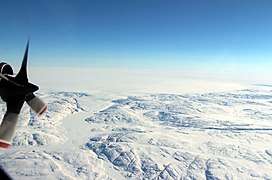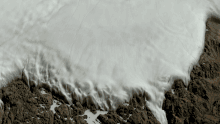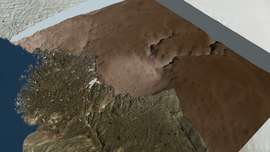Hiawatha Glacier
Hiawatha Glacier is a glacier in northwest Greenland, near Inglefield Land.[1][2] It was mapped in 1922 by Lauge Koch, who noted that the glacier tongue extended into Lake Alida (near Foulk Fjord).[3] Hiawatha Glacier attracted attention in 2018 because of the discovery of a crater beneath the surface of the ice sheet in the area.[4] A publication noted in 1952 that Hiawatha Glacier had been retreating since 1920.[5]
| Hiawatha Glacier | |
|---|---|
 Land-terminating Hiawatha Glacier (left-center) emerging from its semicircular parent ice lobe, in NW Greenland | |
| Coordinates | 78°49′N 67°01′W |
Possible impact structures

| Hiawatha Crater | |
 A still image showing the ice sheet removed in the region around the Hiawatha Glacier and the bed topography under the ice clearly showing the Hiawatha crater | |
| Impact crater/structure | |
|---|---|
| Confidence | potential[6] |
| Diameter | 31 kilometers (19 mi) |
| Depth | 320 meters (1,050 ft) |
| Impactor diameter | 1.5 kilometers (0.9 mi) |
| Age | unknown |
| Exposed | no |
| Drilled | no |
| Bolide type | Iron meteorite |
| Location | |
| Coordinates | 78°44′N 66°14′W |
| Country | Greenland |
| Province | Avannaata |
 Hiawatha Glacier Crater | |
| Access | none |
In November 2018, a study revealed the existence of a large (31-kilometre-wide (19 mi)) circular depression beneath Greenland's ice sheet in the Hiawatha Glacier region—up to a kilometre below the surface of the ice.[6] It has not been dated and its discoverers can only say with certainty that the structure is younger than the 1.985 to 1.740 Ga old Paleoproterozoic bedrock in the region. Some evidence suggests that if it is impact related, it was created after ice covered Greenland three million years ago. News reports about the discovery include speculation that it could be as young as 12,000 years;[7][8] these assertions are based on the Younger Dryas impact hypothesis. Fragments of charcoal up to about 2 cm (0.79 in) in size that were recovered directly from the ice at the tip of the Hiawatha Glacier, where the glacial outwash containing sand interpreted to be either impact melt or shocked metamorphite was collected, yielded an age greater than 50,000 BP. They interpret the charcoal to be wood that had undergone "thermal alteration."[9]
From an interpretation of the crystalline nature of the underlying rock, together with chemical analysis of sediment washed from the crater, the impactor was argued to be a metallic asteroid with a diameter in the order of 1.5 kilometres (0.9 mi). A volume of approximately 20 cubic kilometres (4.8 cu mi) of rock would have been either vaporized or melted. Such an impact would have continued to melt ice flowing into the crater for an as-of-yet undetermined period post-impact. If an impact origin for the crater is confirmed, still to be done, it would be one of the twenty-five largest known impact craters on Earth.[6]
Regardless of its exact age, based on the size of the Hiawatha impact crater, this impact very likely had significant environmental consequences in the Northern Hemisphere and possibly globally.[6]
A NASA glaciologist has discovered in February 2019 a possible second impact crater buried under ice in northwest Greenland. Though the newly found impact sites in northwest Greenland are only 183 km apart, at present they do not appear to have formed at the same time. If the second crater, which has a width of over 35 km, is ultimately confirmed as the result of a meteorite impact, it will be the 22nd largest impact crater found on Earth.[10]
Cape York meteorite

Before the crater was discovered, the Inuit had found iron meteorites in the region. In 1957 an American surveyor found a 48-kilogram (106 lb) meteorite, and in 1963 Vagn F. Buchwald found the 20-ton Agpalilik meteorite (a fragment of the Cape York meteorite) on a nunatak near Moltke Glacier, which is on the Agpalilik peninsula in the Thule district of northwest Greenland.[11][12]
It has been suggested that the Cape York meteorite is part of the main object responsible for creating the Hiawatha crater. Estimates of the Hiawatha impact's age (which is still being studied), along with other indicators, suggest that the crater may be connected with the Younger Dryas impact hypothesis. However, until the impact's age is determined, the connection between the Hiawatha impact and the younger Dryas event remains a suggestion.[13] However, if correct, its associated ejecta would have dispersed as far as Pilauco Bajo in southern Chile.[14] Dating the Hiawatha crater requires drilling almost one km (3,300 ft) through the ice sheet above the crater to obtain a sample of dateable, solidified impact melt from the crater.
See also
- List of possible impact structures on Earth
- Bølling-Allerød warming
- Operation IceBridge
References
- Dawes; et al. (2000). "Kane Basin 1999: mapping, stratigraphic studies and economic assessment of Precambrian and Lower Palaeozoic provinces in north-western Greenland". p. 11.
- "Hiawatha Gletscher: Greenland". Geographical Names. Retrieved November 15, 2018.
- Davies, William E.; Krinsley, Daniel B. (1962). "The recent regimen of the ice cap margin in North Greenland" (PDF). International Association of Scientific Hydrology, Commission of Snow and Ice. p. 124.
- St. Fleur, Niocholas (November 14, 2018). "Ice Age Asteroid Crater Discovered Beneath Greenland Glacier - It is the first crater discovered under one of Earth's ice sheets, according to the scientists who found it". The New York Times. Retrieved November 18, 2018.
- Børge Fristrup (1952). "Die Klimaänderungen in der Arktis und ihre Bedeutung besonders für Grönland". Erdkunde. 6 (4). doi:10.3112/erdkunde.1952.04.01.
- Kjær, Kurt H.; et al. (November 2018). "A large impact crater beneath Hiawatha Glacier in northwest Greenland". Science Advances. 4 (11): eaar8173. Bibcode:2018SciA....4.8173K. doi:10.1126/sciadv.aar8173. PMC 6235527. PMID 30443592.
- Michelle Starr. "A Massive Geological Surprise Has Been Discovered Under Greenland's Ice Sheet". ScienceAlert. Retrieved November 15, 2018.
- Brian Clark Howard. "City-size impact crater found under Greenland ice". National Geographic. Retrieved November 16, 2018.
- Garde, A.A., Funder, S., Guvad, C., Kjær, K.H., Larsen, N.K., Dahl-Møller, J., Nehrke, G., Sanei, H., Søndergaard, A.-S., and Weikusat, C., 2019. Organic Carbon from the Hiawatha Impact Crater, North-West Greenland. 50th Lunar and Planetary Science Conference 2019. LPI Contrib. No. 2132.
- "NASA Finds 2nd Impact Crater Under Greenland Ice". 2019-02-07.
- Derek W. G. Sears (2014). "Oral histories in meteoritics and planetary science—XXV: Vagn F. Buchwald". Meteoritics & Planetary Science. 49 (7): 1271–1287. Bibcode:2014M&PS...49.1271S. doi:10.1111/maps.12332.
- "Discovery of Cape York (Apalilik) Iron Meteorite, Northwest Greenland" (PDF). Meteoritical Bulletin (28): 3. 1963.
- "Greenland ice sheet hides huge 'impact crater'". BBC. Retrieved November 15, 2018.
- Pino, Mario; Abarzúa, Ana M.; Astorga, Giselle; Martel-Cea, Alejandra; Cossio-Montecinos, Nathalie; Navarro, N. Ximena; Lira, Maria Paz; Labarca, Rafael; LeCompte, Malcolm A.; Adedeji, Victor; Moore, Christopher R.; Bunch, Ted E.; Mooney, Charles; Wolbach, Wendy S.; West, Allen; Kennett, James P. (2019). "Sedimentary record from Patagonia, southern Chile supports cosmic-impact triggering of biomass burning, climate change, and megafaunal extinctions at 12.8 ka". Nature. 9: 4413. Bibcode:2019NatSR...9.4413P. doi:10.1038/s41598-018-38089-y. PMC 6416299.

